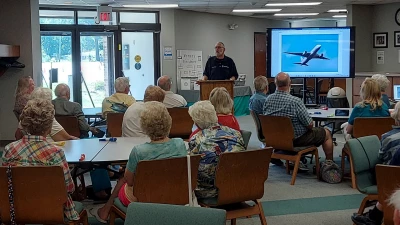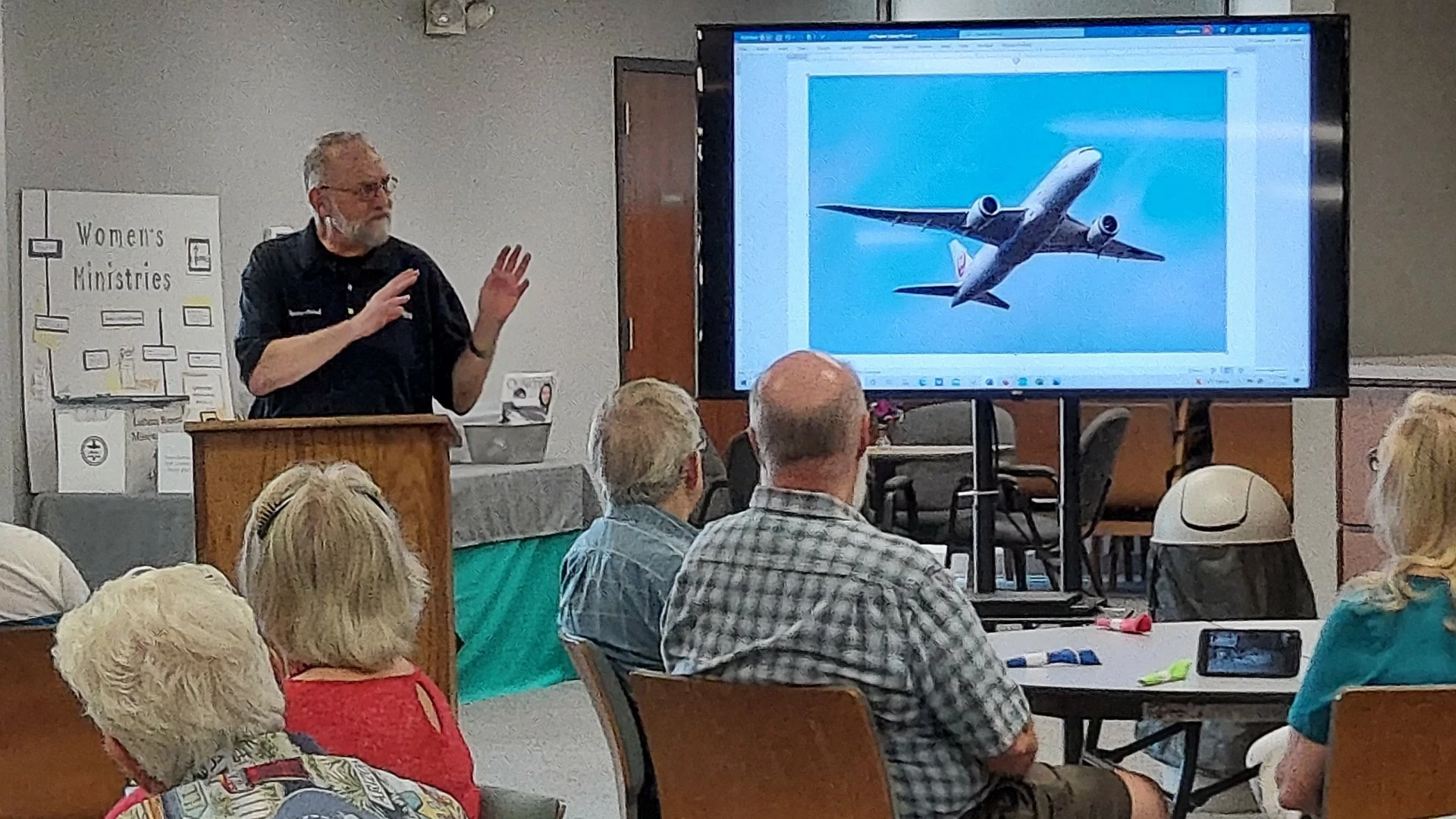TOPICS
• Lightning
• Hail
• Ice
• Birds
• Volcanic Ash
• Catastrophic Engine Failure
• The Future
o The All Electric Engine
o Alternate Fuels
Significant Crashes
Elkton, Maryland Dec 8, 1963 81 died Pan Am Boeing 707
Sioux City Iowa July 19, 1989 185 survived, 112 died Flight 232
Roselawn IN Oct 31, 1994 68 died American Eagle ATR 72
Miracle on the Hudson Jan 15, 1999 155 people rescued US Airways Airbus A320
Kobe Bryant helicopter Jan 26, 2020 9 died
Trump Helicopter Oct 10, 1989 5 died
JFK Jr Martha’s Vineyard July 16, 1999 3 died
What is the reason for most airplane crashes? There is no single cause, crashes are rare, and each incident has a unique root cause. In fact, most incidents have a series of unlikely events, all of which happened and led to a crash.
There are 300 Million commercial flights per year.
Planes are certified by the FAA, &/or the military. Engines too. The FAA (& military) requires tests: hail ingestion, water ingestion, bird ingestion, electric field testing, containment, etc.
Hail, ice, lightning > Weather prediction is so accurate today, planes avoid the weather. Avoidance is the first line of defense. Why? To avoid taking planes out of service for inspections.
Let’s begin with lightning…
Benjamin Franklin and the Invention of the Lightning Rod - SciHi BlogSciHi Blog
The year is (June 1752), the place is Philadelphia. Ben Franklin flies a kite into a storm, with a key on the ground. He proves that lightening is electricy, and invents the Lightening Rod, a.k.a. Lightening Arrestor, a metal rod or wire fixed to an exposed part of a building or other tall structure to divert lightning harmlessly into the ground.
Franklin demonstrated that lightning and electricity were the result of the same phenomenon.
As buildings become taller, lightning becomes more of a threat.
Rounded versus pointed ends
The optimal shape for the tip of a lightning rod has been controversial since the 18th century. IN 2000 it was found that moderately rounded or blunt-tipped lightning rods act as marginally better strike receptors. As a result, round-tipped rods are installed on most new systems in the United States, though most existing systems still have pointed rods.
How many fatalities per year are caused by lightning?
In the United States, the average annual death toll from lightning is around 51 deaths per year, although more recently, in the period 2009 to 2018, the U.S. has averaged only 27 lightning fatalities per year.
Florida is considered the “lightning capital” of the country, with more than 2,000 lightning injuries over the past 50 years.
How many people died from Lightening on airplanes? Zero. You are safer in a plane than being outside.
Pan Am Flight 214 was a scheduled flight of Pan American World Airways from San Juan, Puerto Rico, to Baltimore, Maryland, and Philadelphia, Pennsylvania. On December 8, 1963, the Boeing 707 serving the flight crashed near Elkton, Maryland, while flying from Baltimore to Philadelphia, after being hit by lightning. The crash killed all 81 passengers and crew. This was the last time a plane crashed in the U.S.A. due to lightning.
The average plane gets struck by lightning once a year.
Following the path of least resistance:
Lightning typically makes contact with a protruding part of the plane, such as the nose or the tip of the wing. The aircraft then flies through the lightning flash, which travels along the body, choosing the least resistance path. The lightning typically exits another extremity of the aircraft, such as the tip of the tail.
Even if the flight continues to its destination seemingly unscathed, the aircraft's exterior will be thoroughly checked for damages on the ground. Because the mandatory inspections delay flights and create costs for the airlines, planes avoid flying through thunderstorms if possible.
American Eagle Flight 4184
The second-worst air disaster in Indiana was on Oct. 31, 1994, when American Eagle Flight 4184, bound for Chicago O'Hare from Indianapolis, encountered severe icing conditions, lost control and crashed into a field, killing all 68 people aboard. Roselawn IN.
The ATR 72 performing this route flew into severe icing conditions, lost control and crashed into a field. All 68 people aboard were killed in the high-speed impact.[1]
BOEING 737 MAX – Design Flaw
MCAS Manoeuvering Characteristics Augmentation System (MCAS)
The Boeing 737 is one of the most successful aircraft in history, until...
The grounding of the MAX - Two fatal crashes:
- Lion Air Flight 610 on 29 October 2018. It crashed in the Java Sea shortly after take-off from Soekarno–Hatta International Airport, Jakarta. All 189 people aboard were killed.
- Ethiopian Airlines Flight 302, on 10 March 2019. It crashed shortly after take-off from Addis Ababa, Ethiopia. All 157 people aboard were killed.
The FAA grounded the MAX on March 13th, 2019.
In its conclusions, The NTSB report said:
"That Boeing used in its functional hazard assessment of uncommanded MCAS function for the 737 MAX did not adequately consider and account for the impact that multiple flight deck alerts and indications could have on pilots' responses to the hazard ... The specific failure modes that could lead to unintended MCAS activation (such as an erroneous high AOA input to the MCAS) were not simulated as part of these functional hazard assessment validation tests."
The FAA issued guidance to repair the aircraft faults and improve pilot training in August 2020. Flights resumed in December 2020
Department of Justice
Office of Public Affairs
________________________________________
Thursday, January 7, 2021
Boeing Charged with 737 Max Fraud Conspiracy and Agrees to Pay over $2.5 Billion
The Chicago field offices of the FBI and the DOT-OIG investigated the case, with the assistance of other FBI and DOT-OIG field offices.
VOLCANIC Ash is Toxic
The 14 April 2010 eruption of Iceland's Eyjafjallajökull volcano had a huge impact on air travel, changing the assessment of risk by the aviation sector and catalyzing new lines of scientific investigation. Ash advisories derived from dispersion-model output were issued by the London VAAC, depicting the presence of ash over large parts of Europe and the North Atlantic. Based on those advisories, over 300 airports in about two dozen countries, and a correspondingly large airspace, were closed in Europe during 15-21 April 2010. This resulted in massive impacts on air travel worldwide. Over 100,000 flights were cancelled over that week.
Volcanic ash can abrade forward-facing surfaces, including windscreens, fuselage surfaces, and compressor fan blades. Ash contamination also can lead to failure of critical navigational and operational instruments. Moreover, the melting temperature of the glassy silicate material in an ash cloud is lower than combustion temperatures in modern jet engines; consequently, ash particles sucked into an engine can melt quickly and accumulate as re-solidified deposits in cooler parts, degrading engine performance even to the point of in-flight compressor stall and loss of thrust power.
Ash Cloud Detection and Forecasts
Recent eruptions have prompted the aviation industry, regulators, and scientists to work more closely together to improve the manner in which hazardous airspace is defined, forecast, and communicated.
Miracle on the Hudson
On January 15, 2009, US Airways Flight 1549, an Airbus A320-214 on a flight from New York City's LaGuardia Airport to Charlotte struck a flock of birds shortly after take-off, losing all engine power. Unable to reach any airport for an emergency landing due to their low altitude, pilots Chesley "Sully" Sullenberger and Jeffrey Skiles glided the plane to a ditching in the Hudson River off Midtown Manhattan. All 155 people on board were rescued by nearby boats, with only a few serious injuries.
All passengers were removed from the plane and water by 3.55 pm (24 minutes after the ditching).
As well as fast and appropriate action by the pilots, good weather and clear visibility on the day, an aircraft equipped for a water landing, fast reactions from the cabin crew, and the landing close to boats able to respond all contributed.
What happened to the aircraft
Unusually for an aircraft involved in a crash, the airframe has been preserved, and is an exhibit at The Carolinas Aviation Museum, located at Charlotte Douglas International Airport, North.
 Gene detailed some incidents which resulted in notable crashes. In 1963 a lightning strike caused a mid-air explosion which gave impetus for better shielding and surge suppression on aircraft. A 1994 American Eagle flight crashed in northern Indiana with no survivors. A lengthy holding pattern at O’Hare Airport during inclement weather subjected the aircraft to ice buildup on the wings resulting in the crash. Improvements were made for flexible boots on the leading edge of the wing that permitted shedding of accumulated ice.
Gene detailed some incidents which resulted in notable crashes. In 1963 a lightning strike caused a mid-air explosion which gave impetus for better shielding and surge suppression on aircraft. A 1994 American Eagle flight crashed in northern Indiana with no survivors. A lengthy holding pattern at O’Hare Airport during inclement weather subjected the aircraft to ice buildup on the wings resulting in the crash. Improvements were made for flexible boots on the leading edge of the wing that permitted shedding of accumulated ice.


